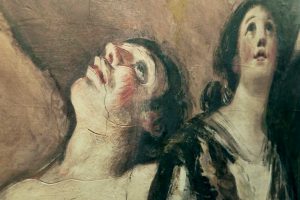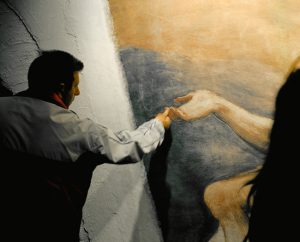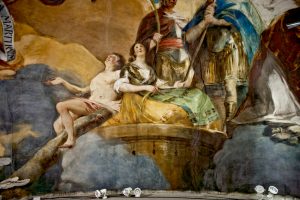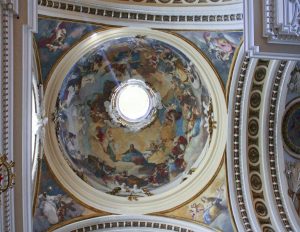“Regina Martirum”

Fresco.
Francisco de Goya.
Basilica del Pilar. Zaragoza.
Commissioned by Fundación Caja Madrid.
Dimensions: 5 x 3.5 meters.
Francisco de Goya leaves his trace in two large frescoes inside the Basilica del Pilar. One of them, the “Martirum Regina” (Queen of Martyrs) painted in 1781, is a colorful and innovative composition that illuminates a dome on the north side of the temple, to nearly fifty meters high.
Considered by many the initiation of impressionist style, is performed with long and thick brushstrokes. The figures, almost blurred, are embedded in a colorful composition; superb and beautiful.
In March 2007, after a long restoration work to finish with the concentration of salts and cracks that threatened the paintings, the Caja Madrid Foundation prepared an interesting exposition about the whole painting and restoration process, which included a fragment replica of the dome in real scale, so that people could come and see the monumental figures painted by the master and other details that could not be seen from the floor of the temple. The selected fragment appears San Sebastian figures leaning on the tree trunk where he was shot through-and Santa Barbara to the feet of two soldiers.


To do the job, a structure was built by strip-spindle-shaped plywood that mounted in transversaly ribs, creating a fragment of full-scale field of the dome. This first support was coated with epoxy resin reinforced with fiberglass.
With a didactic purpose, and for a better understanding on how the mural painting frescos were made, one side of the copy showed all layers of the wall preparation. The bricks where recreated, the first plaster rough, an intermediate and the last, which received the pigments dissolved in water.
The painter’s sketches were transferred to a mortar, still wet, in different ways, Goya left a mark when he pressed on the tracings with a sharp object. It was light and precise marks because the time for the application of color was short, it had to be finished within a day with the mortar still fresh. In this case, the topography left by the genius of the master was a very interesting part to admire the execution process, and then, it was felt that it was a member forming an indivisible whole with the character of the work.
The transferred picture reproduced perfectly the drawing, the length and pressure and each of the original relief. To recreate the strokes, Arsus Papel designed a special mortar incisions allowing the image once applied.
.

the proximity of the copy

relief – appreciable in the photograph – simulating the author’s preparatory incisions. These marks are made to transfer the drawing on the fresh mortar, before applying the paint.

Fragment of the work “Regina Martirum” in the Basilica del Pilar in Zaragoza.

The dome.
